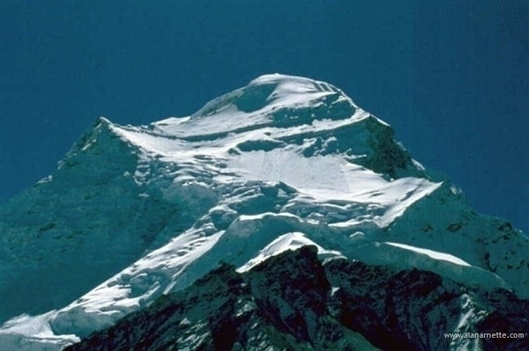 I
climbed Cho Oyu's North West ridge in September 1998. It is located
about 30 miles East of Mt. Everest in the Himalayas. The summit
is 26,907 feet or 8,201 meters and is the 6th tallest mountain
on Earth. I have written a very personal
account of summit day for a deeper insight into what it is
like to climb these big mountains. I went with International
Mountain Guides of Seattle. Borge Ousland was my climbing
partner. An incredible explorer - he is the first and only person
ever to cross Antarctica solo and without any support.
Please visit his site.
I
climbed Cho Oyu's North West ridge in September 1998. It is located
about 30 miles East of Mt. Everest in the Himalayas. The summit
is 26,907 feet or 8,201 meters and is the 6th tallest mountain
on Earth. I have written a very personal
account of summit day for a deeper insight into what it is
like to climb these big mountains. I went with International
Mountain Guides of Seattle. Borge Ousland was my climbing
partner. An incredible explorer - he is the first and only person
ever to cross Antarctica solo and without any support.
Please visit his site.
The trip started with a surprise when only 15 days before departure
Guy Cotter of Adventure Consultants sent me an email informing me
that his trip was canceled and he was trying to hook me up another expedition.
After a week, Eric Simonson, International Mountain Guides, came
to the rescue and included Borge and I on his permit. I traveled to Kathmandu
without knowing who or how I was to travel with to base camp, but
a trust that Eric and Guy were professionals and would make it happen.
We left Kathmandu for Tibet in a huge and brightly colored
truck carrying all our gear. There were four landslides on the road
to Zhangmu. At each landslide, people would magically appear to
carry our gear from one truck to another - for a fee! An amazing demonstration
of human labor. After crossing from Nepal into Tibet (China) through
the border town of Zhangmu, we spent additional aclimitization nights
at Nyalam and Tingri. Each stop was accompanied by short hikes to
the local peaks to increase our red blood cells for the climb up Cho Oyu.
These villages were a step back in time. The buildings were made
of mud and stone. The economy was primarily based on trading and agriculture.
Electricity was as rare as was the telephone service. However in
Tingri, the poorest of the three villages, China had a military base set
up complete with trucks and satellite dishes. The only 2 miles of paved
road for hundreds of miles served as an airplane landing strip.
After a week of traveling, we left Tingri by jeep to base camp (BC) where we found the IMG expedition's tents. Borge and I spent
another 4 days here climbing the locals once again up to 18,000. Since
the rest of the expedition had already moved to Advanced base camp
(ABC) and we had to wait for one of the Guides to return to BC. This
was an interesting area with all the other expeditions arriving, loading
yaks and departing for their climbs. At 15,500', BC sits on a grassy
plain surrounded by brown and sometimes snow-capped pointed peaks.
I felt like I was as far away from civilization as I had every been.
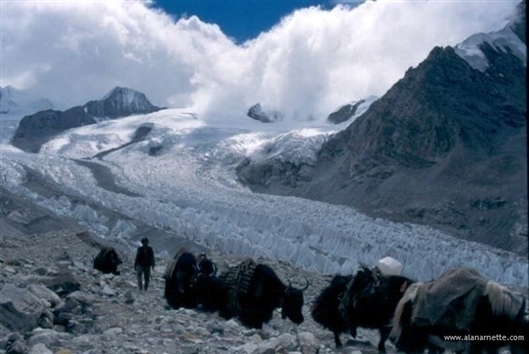 It
took about six hours to trek the 15 miles to ABC at 18,500. At one
point the trail snaked over a small hilltop to expose the Gyabrag
Glacier. We saw several yak trains returning from ABC void of
their loads. The rugged mountains looming high above the glacier was a
festival for the eyes as the yaks meandered along the trail. Arriving
at ABC, I had mixed emotions. ABC is a sea of huge boulders surrounded
by 22,000 mountains all covered with intensely bright white snow and ice.
Each tent was carefully placed on it own flat area made as smooth
as possible by removing rocks that would torture you during the night.
It is hot when the sun is out and unbearably cold in the dark and when
the sky is filled with clouds. Cho Oyu stands directly to the East of
ABC - huge, high, perfectly white with deep snow and unmoving to the eye. It
took about six hours to trek the 15 miles to ABC at 18,500. At one
point the trail snaked over a small hilltop to expose the Gyabrag
Glacier. We saw several yak trains returning from ABC void of
their loads. The rugged mountains looming high above the glacier was a
festival for the eyes as the yaks meandered along the trail. Arriving
at ABC, I had mixed emotions. ABC is a sea of huge boulders surrounded
by 22,000 mountains all covered with intensely bright white snow and ice.
Each tent was carefully placed on it own flat area made as smooth
as possible by removing rocks that would torture you during the night.
It is hot when the sun is out and unbearably cold in the dark and when
the sky is filled with clouds. Cho Oyu stands directly to the East of
ABC - huge, high, perfectly white with deep snow and unmoving to the eye.
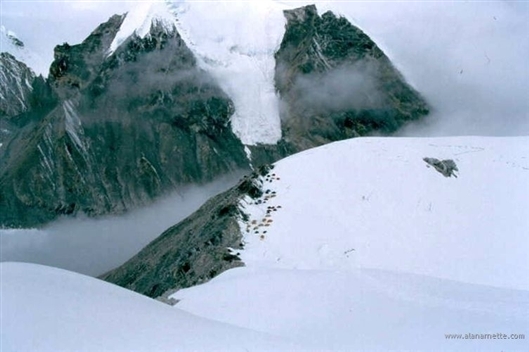
After a day's rest and time to meet the rest of the team, we left for an
overnight stay at Camp 1. For me, this became the most dreaded trek on
Cho Oyu. It takes 3
to 5 hours over very rocky terrain in which you carry heavy loads. Just
when you think you should be there, a steep hill appears covered with tiny,
gravel sized pebbles that move with each step. If it had snowed, they are
covered with ice. The 1,000 scree hill takes another hour to overcome.
On top, there is C1 at 20,600. A checkerboard area with red, yellow and
blue tents resting on a football field size snow ridge. The trail to Camp 2 is clearly visible but after the long day, most everyone melts snow and
gets some rest.
Back down to ABC for rest and back up to C1 and on to C2. This is the 'climb
high, sleep low' schedule for 8,000m peaks. Borge and I were feeling good
so we decided to make our summit bid a couple days earlier than the rest
of the team. This proved to be a good decision based on the developing
weather. We returned to C1 and then moved to C2. The climb from C1 to C2
is the most difficult technically on Cho Oyu. It requires most of the day
and presents an interesting challenge at the halfway point. A 30 degree
icewall requires you to jumar up fixed ropes. Not too difficult really,
but at almost 22,000' it presented a stiff challenge to overcome.
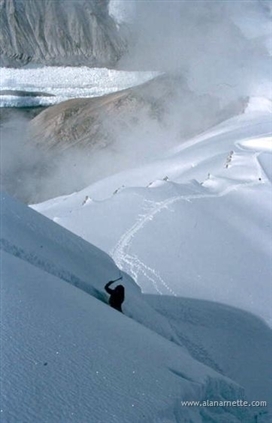
Above the icefall, we moved steadily up the mountain
when we got the news over the radio that a climber on our
permit, Alex Jaggi, had died after summiting with his partner
Keitaro Mooroka and their Sherpa Norbu. Stunned by this tragedy,
we sat quietly in the snow unsure what had happened or what
to do next. They had made the summit and had returned to C2,
our destination. When Keitaro and Norbu checked on Alex, who
was seeping alone in another tent, he was dead. He had slept
with bottled oxygen and had food and water next to him. It
is still unknown what caused his death but it devastated Keitaro
who quickly descended off the mountain.
The remainder of the climb was long. The sun came out and
I was extremely hot, removing layer after layer. Soon I became sunburned
and dehydrated. I was hurting. Finally we arrived at C2 under a cloud
of despair. Alex's tent was inconspicuous in the group of 20 or more
pitched together on a flat section of Cho Oyu at 23,000'. After a fitful
night, we rose to the thought that Alex needed to be buried. Under
the leadership of Bob Slozen, our lead Guide who had climbed from C1
to C2 in an amazing time, Alex was laid to rest in a nearby crevasse
after a short ceremony. Borge said a prayer in Norwegian and we all
retreated to private thoughts and feelings.
An hour later, we left for Camp 3 at 24,500' and our summit
bid. Bob returned to ABC to deal with the Chinese Mountain Authority
on the details of Alex's death. The climb to C3 was not too bad and
we arrived in about 4 hours. However, the wind had picked up and it
was snowing hard upon our arrival. Borge and I were in one tent and
our guides, Jethro and Heather in another. The wind beat the tent walls
without mercy from 6:00 PM to midnight. Borge and I slept with oxygen
that night sharing the mask since the splitter was left behind at ABC.
Every hour one of us would awaken and give the mask to the other. Between
this interruption, the howling of the wind and the memory of the morning,
there was little sleep that night.
Abut 1:00AM, Heather called out for us to prepare for the
summit bid. Eerily, the wind had stopped thus creating a strange
quietness at the edge of the Death Zone. We melted water and ate
some cereal bars as we put on all our down. With headlamps providing
the only light on this moonless night, we assembled our harnesses
and crampons, clipped into a fixed rope and began our assent of Cho Oyu.
Our progress came to a halt after only one hour at the yellow
band - a 100' limestone wall that runs throughout the Himalayas
at 25,500'. The other expeditions were having trouble scaling the wall
and I watched one climber after another do Olympic gymnastics
on the ropes. Finally we got our turn and continued the climb. The sun
came out but since we were on the West side of the mountain, we climbed
in the shade for hours. I never really got too cold except while waiting
at the yellow band. I became used to the sound of my own breathing in
the oxygen mask as I climbed higher. Above 26,000' it became harder and
harder. Each step required a conscious effort as did each breath. I was
keenly aware of our turn around time of noon and it was approaching
11:00 as we made slow progress up the final slope to the summit
plateau.
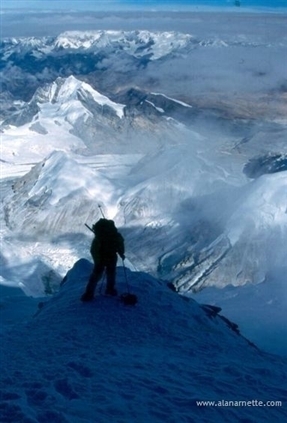
We passed climbers turning around and going up. It was like
a refuge march with walking wounded everywhere. It soon became clear
that I would not make the true summit, a small hill atop the plateau,
by the turnaround time, so upon reaching the plateau of 26, 600', Heather
and I returned to C3. The downclimb was long and tiring. I was pleased
with my performance since this was my first time at this altitude but
I was also extremely disappointed that I did not make the true summit.
But I did return home safely.
The rest of the team never got higher than C2 since it began
to snow hard with blizzard conditions.
Cho Oyu is not a technically difficult climb. It is a long
expedition and requires significance stamina, will power and strength.
Altitude is a killer - by any definition. Our experience was a lesson
in the dangers of climbing these big mountains. All the preparation
in the world sometimes cannot prevent tragedy. The team dynamics on
this trip was the most difficult of any of my expeditions. I learned
so many valuable lessons that I have applied on every trip afterwards.
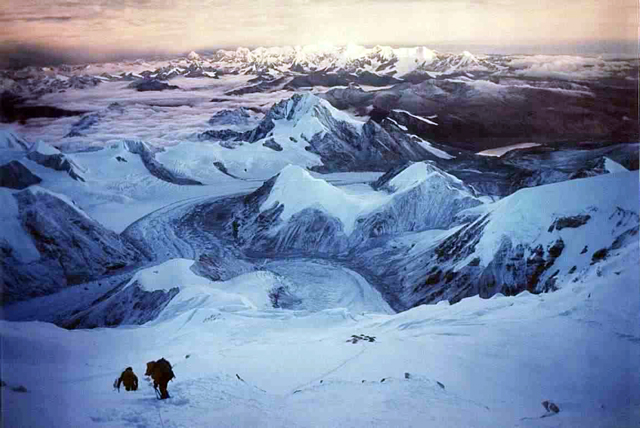
Alan on the way to the summit with guide Heather Macdonald
at 26,000 feet on Tibet's Cho Oyu.
Photo taken by Borge Ousland on September 28, 1998. |
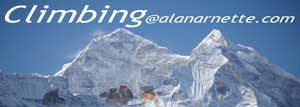

 I
climbed Cho Oyu's North West ridge in September 1998. It is located
about 30 miles East of Mt. Everest in the Himalayas. The summit
is 26,907 feet or 8,201 meters and is the 6th tallest mountain
on Earth. I have written a very personal
account of summit day for a deeper insight into what it is
like to climb these big mountains. I went with International
Mountain Guides of Seattle. Borge Ousland was my climbing
partner. An incredible explorer - he is the first and only person
ever to cross Antarctica solo and without any support.
Please visit his site.
I
climbed Cho Oyu's North West ridge in September 1998. It is located
about 30 miles East of Mt. Everest in the Himalayas. The summit
is 26,907 feet or 8,201 meters and is the 6th tallest mountain
on Earth. I have written a very personal
account of summit day for a deeper insight into what it is
like to climb these big mountains. I went with International
Mountain Guides of Seattle. Borge Ousland was my climbing
partner. An incredible explorer - he is the first and only person
ever to cross Antarctica solo and without any support.
Please visit his site. It
took about six hours to trek the 15 miles to ABC at 18,500. At one
point the trail snaked over a small hilltop to expose the Gyabrag
Glacier. We saw several yak trains returning from ABC void of
their loads. The rugged mountains looming high above the glacier was a
festival for the eyes as the yaks meandered along the trail. Arriving
at ABC, I had mixed emotions. ABC is a sea of huge boulders surrounded
by 22,000 mountains all covered with intensely bright white snow and ice.
Each tent was carefully placed on it own flat area made as smooth
as possible by removing rocks that would torture you during the night.
It is hot when the sun is out and unbearably cold in the dark and when
the sky is filled with clouds. Cho Oyu stands directly to the East of
ABC - huge, high, perfectly white with deep snow and unmoving to the eye.
It
took about six hours to trek the 15 miles to ABC at 18,500. At one
point the trail snaked over a small hilltop to expose the Gyabrag
Glacier. We saw several yak trains returning from ABC void of
their loads. The rugged mountains looming high above the glacier was a
festival for the eyes as the yaks meandered along the trail. Arriving
at ABC, I had mixed emotions. ABC is a sea of huge boulders surrounded
by 22,000 mountains all covered with intensely bright white snow and ice.
Each tent was carefully placed on it own flat area made as smooth
as possible by removing rocks that would torture you during the night.
It is hot when the sun is out and unbearably cold in the dark and when
the sky is filled with clouds. Cho Oyu stands directly to the East of
ABC - huge, high, perfectly white with deep snow and unmoving to the eye.

